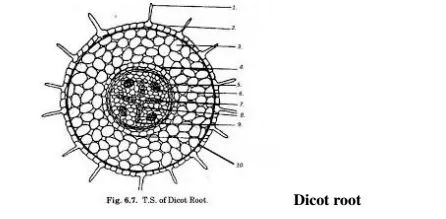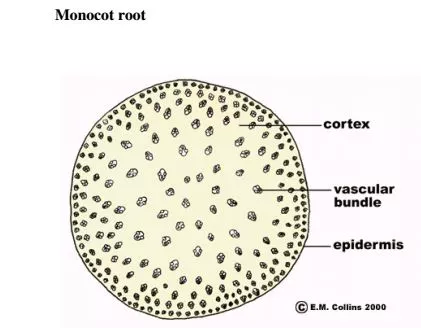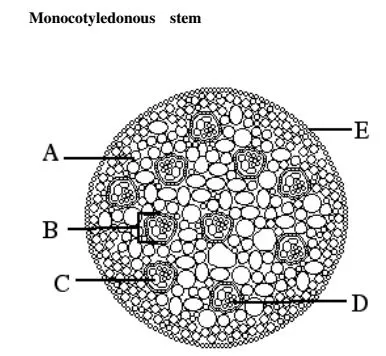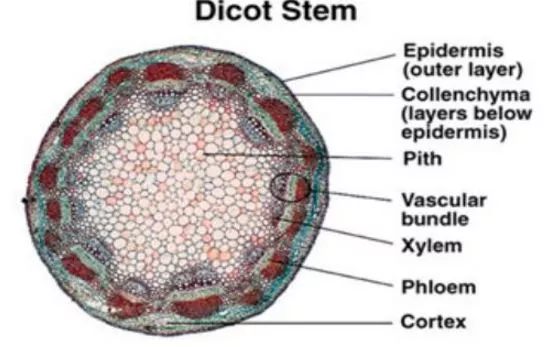Biology Questions and Answers Form 2
Biology Questions and Answers Form 2
K.C.S.E Online Revision
Biology Questions and Answers Form 2
KCSE Revision Questions and Answers
Biology Notes Form 2
1. a) i) Define transport
- Movement of substances from one pan of the body to anotherii) Explain the necessity of transport in plants and animals
- make nutrients move from one point to another
- movement of respiratory gases i.e. oxygen and carbon IV oxide
- elimination of metabolic wastes
- movement of hormones
- movement of water
- movement of salts
- movement of enzymesb) i) Describe the structure and function of root hair
- root hairs are found near the root tip
- they are cells with elongated finger-like projections which are in contact with soil particles
- they are permeable to water and mineral salts hence are used to absorb Water and mineral salts
- There large number offers a large surface area for absorption of water and mineral salts.ii) State ways in which the root hairs are adapted to their functions
- the root hair is long/narrow/numerous to increase surface area for absorption of water and mineral salts
- many mitochondria in cytoplasm to supply energy for active transport of mineral salts
- are thin walled to speed up rate of absorption of Water and mineral saltsc) i) Compare the internal structure of a dicotyledonous root and a monocotyledonous root

Monocot root

ii) State the similarities and differences between a dicotyledonous and monocotyledonous root
Similarities
- both used for anchorage and absorption of water and mineral salts
- both have root hairs, epidermis, pericycle, cortex, endodermis and vascular bundles
- (xylem and phloem)
- both may be used to store food/storage organsDifferences
Monocotyledonous
- phloem and xylem are arranged in ring form alternately
- pith presentDicotyledonous
- phloem lies between radial rays of central xylem(star shaped)
- pith absentiii) Compare the internal structure of a monocotyledonous and dicotyledonous stem
Monocotyledonous stem

Dicotyledonous stem

i) Give the similarities and differences between a monocotyledonous and dicotyledonous stem
Similarities
- both are used for protection
- both conduct water, salts and food
- both have epidermis, cortex, pericycle and vascular bundlesDifferences
Monocotyledonous
- vascular bundles are many and scattered
- some have hollow pith or pith is absent
- no cambium layer therefore cannot
- undergo secondary growth very
- little cortexDicotyledonous
- vascular bundles are few and arranged in a concentric ring near the epidermis
- pith large and well developedState the differences between the internal structure of a root and a stem.
- no cambium layer therefore cannot
- undergo secondary growth
- very little cortex
- presence of cambium therefore
- undergoes secondary growth
- cortex has several layers of cellsc) i) Name the transport structures of a flowering plant
- xylem vessels and tracheids transport water and mineral salts from the soil
- Phloem vessels translocate manufactured food from leaves to other parts of the bodyii) State the ways in which xylem vessels are adapted to their function
- lignified/thickened to prevent collapsing
- narrow to facilitate capillary
- no cross walls for continuous flow/column of water
- have bordered pits for lateral movement of watera) i) Why do flowering plants need water?
- photosynthesis
- transport
- turgidity w h helps in plant support
- solvent i.e. medium for chemical reactions
- cooling effect during transpiration
- seed germinationii) Describe the movement of water from the soil to the leaves of a tall plant
- Soil water exists as a thin film in the soil, between soil particles
- the concentration of cell sap of root hair is greater than that of the surrounding solution in the soil, thus drawing the Water molecules across the cell wall and cell membrane into the root hair by osmosis
- water drawn into the root hair cell dilutes the cell sap making it less concentrated than that in the adjacent cortex cells of the root
- due to osmotic gradient water moves from the root hair cells into the cortex by osmosis, from cell to cell by osmosis, across the endodermis by active transport into xylem vessels of the root that conduct water into xylem vessels of the stem into xylem vessels of the leavesStem
- Once in the stem water moves up the plant aided by the narrowness of the xylem vessels (capillary), root pressure, attraction of water molecules to each other (cohesion).
- Attraction of water molecules to the Walls (adhesion) from the stem water enters the xylem of leaves
- water moves in the xylem vessels of the stem in a continuous (uninterrupted) water column up to the tree leavesLeaves
- once in the leaves water moves into the mesophyll cells by osmosis as water vaporizes from the spongy mesophyll cells their sap becomes more concentrated than the adjacent cells as the result water flows into the cell from other surrounding cells which in turn takes in water from xylem vessels within the leaf veins this creates a pull(suction force) called transpiration pull that pulls a stream of water from xylem vessels in the stem and roots .
- The transpiration pull maintains a continuous column of water from the roots to the leaves.iii) Name the process by which mineral salts enter into a plant
- active transport
- diffusioni) Explain the forces that make water and mineral salts move through a plant
- mineral salts are taken up due to diffusion because of the concentration gradient between the mineral ions in sap and those in soil solution
- active transport involves energy in form of ATP due to respiration which forces mineral salts through a plant against a concentration gradient
- water moves by osmosis through a semi-permeable membrane of root hairs and between cells of stem
- in stem water moves by cohesion(attraction of water molecules to each other)
- it also moves by adhesion(attraction of water molecules to walls)
- capillarity is due to narrowness of xylem vessels
- transpiration pull occurs When Water vapour evaporates from sub-stomatal chambers into the air
- root pressure is a force that pushes Water up the stem from the roots and causes guttation /exudationii) Explain the uptake of mineral salts by plants
- plants require mineral salts for metabolism and proper functioning of their bodies
- mineral salts are taken up from the soil into the root hairs in form of solution by active
- transport which requires energy
- active transport involves substances called carriers taken up together with water and are then carried to the stems and leaves
- the main process involved in uptake and movement of mineral salts is active transportb) i) What is transpiration?
- loss of water from plant to the atmosphereii) Name the sites through which transpiration takes place in a plant
- stomata (stomatal transpiration)
- lenticels (lenticular transpiration)
- cuticle(cuticular transpiration)iii) State the importance of transpiration to plants
- cooling the plant
- transport of water
- transport of mineral salts
- excretion of excess Water from plantsexcess transpiration causes wilting
i) Explain the structural factors that affect the rate of transpiration in plants
- number of stomata i.e. the more the stomata the higher the rate and vice versa
- turgidity of the guard cells which control the opening and closing of stomata when they are open transpiration rate is high
- size of leaves where the larger the surface area the higher the rate of transpiration
- leaf fall leads to lower rate of transpiration and also drying of leaves reduces rate of transpiration
- Thin cuticle reduces distance through Which water vaporizes hence increase transpiration rate. Absence of cuticle also increase rate of transpirationii) Explain the environmental factors that affect rate of transpiration in plants
- high temperature increases rate of transpiration and low temperature reduces the rate
- humidity when high increases rate and when low reduces the rate
- transpiration rate is higher in moving air (wind) than in still air
- high light intensity increases internal temperature hence higher rate of evaporation leading to higher rate of transpiration
- availability of water in the soil leads to more absorption hence more loss to the atmosphere
- atmospheric pressure when high leads to more evaporation and when low leads to low rate evaporation of wateriii) State the structural differences between xylem vessels and sieve tubes
- sieve tubes have cross wall while xylem vessels have none
- xylem vessels are lignified while sieve tubes are not
- Sieve tubes have cytoplasm elements while xylem vessels have none.iv) State the adaptations of plants which enable them to reduce water loss
- thick waxy cuticle
- reduced leaf size/thorns/spines
- shedding of leaves
- Sunken stomata. Water vapour accumulates in the depression of stomata lowering the water vapour concentration gradient leading to lower rate of evaporation
- rolling of leaves
2024 FORM 1 2 3 4 REVISION RESOURCES
FORM 1 2 3 4 TERM 1 2 3 OPENER , MID AND END TERM EXAMS
1995-2024 KCSE KNEC PAPERS QUESTIONS,ANSWERS AND REPORT
2008-2024 KCSE FORM 4 COUNTY MOCKS
FORM 1 2 3 4 SCHEMES OF WORK
FORM 1 2 3 4 LESSON PLANS
FORM 1 2 3 4 CLASS REVISION NOTES
FORM 1 2 3 4 TERM 1 2 3 HOLIDAY ASSISNMENTS
FORM 3 4 SETBOOKS STUDY GUIDES
FORM 1 2 3 4 TOPICAL TESTS
FORM 1 2 3 4 REVISION BOOKLETS
LIFE SKILLS NOTES
FORM 1 2 3 4 SYLLABUS
KENYA SCHOOL CODES
HOW TO REVISE AND PASS EXAMS
GUIDANCE AND CONSELLING NOTES




 WhatsApp us Now
WhatsApp us Now